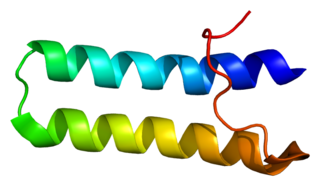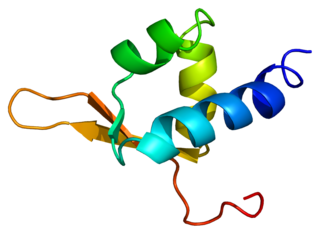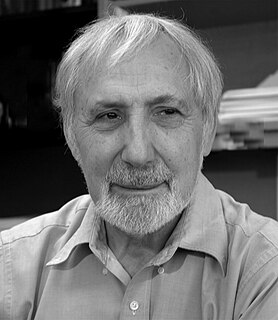Related Research Articles

Heme, or haem, is a precursor to hemoglobin, which is necessary to bind oxygen in the bloodstream. Heme is biosynthesized in both the bone marrow and the liver.

Peptide mass fingerprinting (PMF) is an analytical technique for protein identification in which the unknown protein of interest is first cleaved into smaller peptides, whose absolute masses can be accurately measured with a mass spectrometer such as MALDI-TOF or ESI-TOF. The method was developed in 1993 by several groups independently. The peptide masses are compared to either a database containing known protein sequences or even the genome. This is achieved by using computer programs that translate the known genome of the organism into proteins, then theoretically cut the proteins into peptides, and calculate the absolute masses of the peptides from each protein. They then compare the masses of the peptides of the unknown protein to the theoretical peptide masses of each protein encoded in the genome. The results are statistically analyzed to find the best match.

Eosinophil major basic protein, often shortened to major basic protein is encoded in humans by the PRG2 gene.

Bone sialoprotein (BSP) is a component of mineralized tissues such as bone, dentin, cementum and calcified cartilage. BSP is a significant component of the bone extracellular matrix and has been suggested to constitute approximately 8% of all non-collagenous proteins found in bone and cementum. BSP, a SIBLING protein, was originally isolated from bovine cortical bone as a 23-kDa glycopeptide with high sialic acid content.

Caspase-10 is an enzyme that, in humans, is encoded by the CASP10 gene.

Phosphoglycerate kinase 1 is an enzyme that in humans is encoded by the PGK1 gene.

Leukotriene A4 hydrolase, also known as LTA4H is a human gene. The protein encoded by this gene is a bifunctional enzyme which converts leukotriene A4 to leukotriene B4 and acts as an aminopeptidase.

Platelet glycoprotein Ib alpha chain also known as glycoprotein Ib (platelet), alpha polypeptide or CD42b, is a protein that in humans is encoded by the GP1BA gene.

Calcium/calmodulin-dependent protein kinase type II gamma chain is an enzyme that in humans is encoded by the CAMK2G gene.

Laminin subunit alpha-1 is a protein that in humans is encoded by the LAMA1 gene.

Megakaryocyte-associated tyrosine-protein kinase is an enzyme that in humans is encoded by the MATK gene.

Glycophorin B also known as sialoglycoprotein delta and SS-active sialoglycoprotein is a protein which in humans is encoded by the GYPB gene. GYPB has also recently been designated CD235b.

Golgi-associated PDZ and coiled-coil motif-containing protein is a protein that in humans is encoded by the GOPC gene.

Annexin A7 is a protein that in humans is encoded by the ANXA7 gene.

Bifunctional aminoacyl-tRNA synthetase is an enzyme that in humans is encoded by the EPRS gene.

Triadin, also known as TRDN, is a human gene associated with the release of calcium ions from the sarcoplasmic reticulum triggering muscular contraction through calcium-induced calcium release. Triadin is a multiprotein family, arising from different processing of the TRDN gene on chromosome 6. It is a transmembrane protein on the sarcoplasmic reticulum due to a well defined hydrophobic section and it forms a quaternary complex with the cardiac ryanodine receptor (RYR2), calsequestrin (CASQ2) and junctin proteins. The luminal (inner compartment of the sarcoplasmic reticulum) section of Triadin has areas of highly charged amino acid residues that act as luminal Ca2+ receptors. Triadin is also able to sense luminal Ca2+ concentrations by mediating interactions between RYR2 and CASQ2. Triadin has several different forms; Trisk 95 and Trisk 51, which are expressed in skeletal muscle, and Trisk 32 (CT1), which is mainly expressed in cardiac muscle.

General transcription factor IIF subunit 2 is a protein that in humans is encoded by the GTF2F2 gene.
Hydrophobicity scales are values that define the relative hydrophobicity or hydrophilicity of amino acid residues. The more positive the value, the more hydrophobic are the amino acids located in that region of the protein. These scales are commonly used to predict the transmembrane alpha-helices of membrane proteins. When consecutively measuring amino acids of a protein, changes in value indicate attraction of specific protein regions towards the hydrophobic region inside lipid bilayer.

Synapsin I, is the collective name for Synapsin Ia and Synapsin Ib, two nearly identical phosphoproteins that in humans are encoded by the SYN1 gene. In its phosphorylated form, Synapsin I may also be referred to as phosphosynaspin I. Synapsin I is the first of the proteins in the synapsin family of phosphoproteins in the synaptic vesicles present in the central and peripheral nervous systems. Synapsin Ia and Ib are close in length and almost the same in make up, however, Synapsin Ib stops short of the last segment of the C-terminal in the amino acid sequence found in Synapsin Ia.

George Stark is an American chemist and biochemist. His research interests include protein and enzyme function and modification, interferons and cytokines, signal transduction, and gene expression.
References
- ↑ "Obituary - Gary K. Ackers". Biophysical Society. August 2011. Retrieved 15 July 2013.
- ↑ Gary Ackers Archived 2010-06-07 at the Wayback Machine faculty page at Washington University in St. Louis. Accessed on 2010-02-01.
- ↑ Ackers GK (1967). "Molecular sieve studies of interacting protein systems. I. Equations for transport of associating systems". J. Biol. Chem. 242 (13): 3026–3034. doi: 10.1016/S0021-9258(18)95928-4 . PMID 6027787.
- ↑ Ackers GK (1969). "Molecular sieve studies of interacting protein systems. IV. Molecular size of the D-amino acid oxidase apoenzyme subunit". J. Biol. Chem. 244 (2): 465–470. doi: 10.1016/S0021-9258(18)94452-2 . PMID 4388073.
- ↑ Pettigrew DW, Romeo PH, Tsapis A, Thillet J, Smith ML, Turner BW, Ackers GK (1982). "Probing the energetics of proteins through structural perturbation: sites of regulatory energy in human hemoglobin". PNAS . 79 (6): 1849–1853. Bibcode:1982PNAS...79.1849P. doi: 10.1073/pnas.79.6.1849 . PMC 346078 . PMID 6952235.
{{cite journal}}: CS1 maint: multiple names: authors list (link)